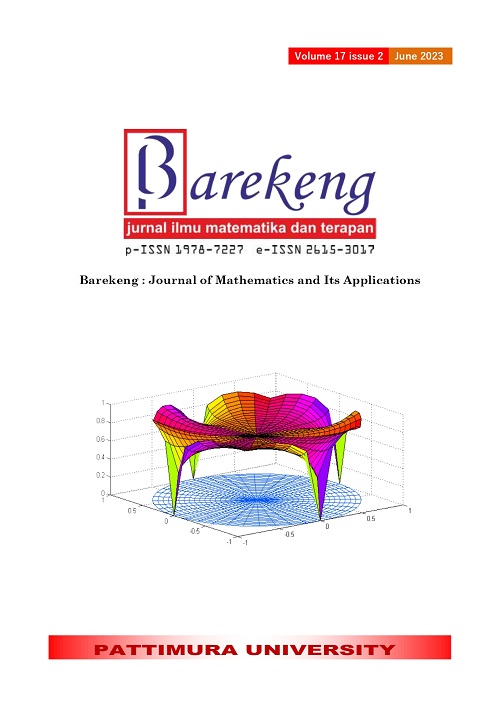COVID-19 PROJECTIONS ON JAVA AND BALI ISLANDS INVOLVING VACCINATION AND TESTING INTERVENTIONS USING VARI-X MODEL
Abstract
The Indonesian government implemented the policy of increasing vaccination and testing of Covid-19 for travel from or to the Java and Bali Islands to reduce the Covid-19 projected spread in there. As participation in these efforts, this study aims to project the Covid-19 spread measured by the active case rates by involving the intervention of vaccination and testing of Covid-19 in the two islands. Projections are performed using a vector of autoregression integrated with the exogenous variables (VARI-X) model. This model is used because it can simultaneously project the Covid-19 spread in the two islands by involving interventions of vaccination and testing of Covid-19 as exogenous variables. The most suitable model obtained is VARI-X (4, 2, 0). The mean-absolute-percentage error (MAPE) of the model for the Java and Bali Islands is 5.3027% and 3.0301%, respectively. Based on the MAPE value, the model is very accurate for projecting the future Covid-19 spread on the two islands. This accuracy can be seen practically from the Covid-19 spread projection results in the next four days, which are very close to the actual data. This research is expected to help the Indonesian government project the spread of Covid-19 on the Java and Bali Islands.
Downloads
References
M. N. Cahyadi et al., “Spatiotemporal Analysis for COVID-19 Delta Variant Using GIS-Based Air Parameter and Spatial Modeling,” Int. J. Environ. Res. Public Health, vol. 19, no. 3, 2022, doi: 10.3390/ijerph19031614.
A. Matulessy, A. F. Rakhim, and A. Pascarini, “Understanding Social Support and Work Meaning To Reduce Work Stress for Police Officers during the Covid-19 Pandemic,” Rev. Int. Geogr. Educ. Online, vol. 11, no. 3, 2021, doi: 10.33403/rigeo.800563.
P. D. Wijaya, A. A. N. E. S. Gorda, J. J. P. Latupeirissa, and I. A. O. Martini, “Exploring the Human Resource Practices in Employee Performance: The Mediating Role of Organization Commitment and Citizenship Behavior,” Rev. Int. Geogr. Educ. Online, vol. 11, no. 5, 2021, doi: 10.48047/rigeo.11.05.222.
S. Sutomo, S. Sagala, B. Sutomo, W. Liem, and H. Al Hamid, “Strengthening the strategic and operational response forreducing covid-19 transmission in Indonesia,” Kesmas, vol. 16, 2021, doi: 10.21109/kesmas.v0i0.5104.
H. Harapan et al., “Willingness-to-pay for a COVID-19 vaccine and its associated determinants in Indonesia,” Hum. Vaccines Immunother., vol. 16, no. 12, 2020, doi: 10.1080/21645515.2020.1819741.
K. Khoirunurrofik, F. Abdurrachman, and L. A. M. Putri, “Half-hearted policies on mobility restrictions during COVID-19 in Indonesia: A portrait of large informal economy country,” Transp. Res. Interdiscip. Perspect., vol. 13, 2022, doi: 10.1016/j.trip.2021.100517.
S. Suprayitno, R. Rahmi, and L. Christiani, “Commuters’ health certificate as social control during the COVID-19 pandemic,” Proc. from Doc. Acad., vol. 8, no. 2, 2021, doi: 10.35492/docam/8/2/3.
A. Wirawan and P. P. Januraga, “Forecasting COVID-19 Transmission and Healthcare Capacity in Bali, Indonesia,” J. Prev. Med. Public Heal., vol. 53, no. 3, 2020, doi: 10.3961/JPMPH.20.152.
I. G. N. M. Jaya and H. Folmer, “Bayesian spatiotemporal forecasting and mapping of COVID-19 risk with application to West Java Province, Indonesia,” J. Reg. Sci., vol. 61, no. 4, 2021, doi: 10.1111/jors.12533.
U. S. Pasaribu, U. Mukhaiyar, N. M. Huda, K. N. Sari, and S. W. Indratno, “Modelling COVID-19 growth cases of provinces in java Island by modified spatial weight matrix GSTAR through railroad passenger’s mobility,” Heliyon, vol. 7, no. 2, 2021, doi: 10.1016/j.heliyon.2021.e06025.
Subiyanto, Y. Hidayat, E. Afrianto, and S. Supian, “Numerical estimation of the final size of the spread of covid-19 in west java province, indonesia,” Eng. Lett., vol. 29, no. 3, 2021.
R. S. TSAY, Multivariate Time Series Analysis With R and Financial Applications, vol. 7, no. 1. 2014.
M. Kulshreshtha and J. K. Parikh, “Modeling demand for coal in India: Vector autoregressive models with cointegrated variables,” Energy, vol. 25, no. 2, 2000, doi: 10.1016/S0360-5442(99)00059-6.
A. R. Putri, M. Usman, Warsono, Widiarti, and E. Virginia, “Application of Vector Autoregressive with Exogenous Variable: Case Study of Closing Stock Price of PT INDF.Tbk and PT ICBP.Tbk,” in Journal of Physics: Conference Series, 2021, vol. 1751, no. 1, doi: 10.1088/1742-6596/1751/1/012012.
W. W. S. Wei, Time Series Analysis: Univariate and Multivariate Methods Second Edition, vol. SFB 373, no. Chapter 5. 2006.
Y. Zhang, M. Zhong, N. Geng, and Y. Jiang, “Forecasting electric vehicles sales with univariate and multivariate time series models: The case of China,” PLoS One, vol. 12, no. 5, 2017, doi: 10.1371/journal.pone.0176729.
Copyright (c) 2023 Riza Andrian Ibrahim, Budi Nurani Ruchjana

This work is licensed under a Creative Commons Attribution-ShareAlike 4.0 International License.
Authors who publish with this Journal agree to the following terms:
- Author retain copyright and grant the journal right of first publication with the work simultaneously licensed under a creative commons attribution license that allow others to share the work within an acknowledgement of the work’s authorship and initial publication of this journal.
- Authors are able to enter into separate, additional contractual arrangement for the non-exclusive distribution of the journal’s published version of the work (e.g. acknowledgement of its initial publication in this journal).
- Authors are permitted and encouraged to post their work online (e.g. in institutional repositories or on their websites) prior to and during the submission process, as it can lead to productive exchanges, as well as earlier and greater citation of published works.






1.gif)



